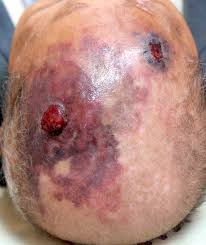 Angiosarcoma aggressive soft tissue sarcoma.
Angiosarcoma aggressive soft tissue sarcoma.
Accounts for approximately 1.6% of soft tissue sarcoma is in the US.
Poor prognosis with a five-year survival of approximately 30-45%.
Prognosis depends on tumor site and patient’s age,.
Tumors of the head and neck and have a lower survival compared with tumors other sites.
Present as tender, violaceous, ecchymotic patches or plaques.
Usually develop in sites of prior radiation, sites of chronic lymphedema, or spontaneously on the head and neck of elderly patients.
Lesions range in size from less than 1 cm to more than 35 cm.
In general, the prognosis is worse for larger tumors.
Post irradiation angiosarcoma tends to develop 5-10 years after radiation therapy but can occur much later.
Stewart-Treves syndrome angiosarcoma develops within areas of chronic lymphedema.
Biopsy of the lesion is required to diagnose cutaneous angiosarcoma.
Histologically blood vessel proliferation by atypical endothelial cells with prominent extravasation of erythrocytes.
Lesions stain positively for endothelial markers including CD31, CD34, vascular endothelial growth factor, von Willebrand factor and Ulex europoeus agglutinin1.
Differentiating angiosarcoma from Kaposi’s sarcoma is difficult, but the latter routinely stains for human herpesvirus eight which angiosarcoma does not.
Lesions tend to metastasize hematogenously, most often to the lungs.
Lymph node metastases do occur.
Meetastatic assessment includes CT scan of the chest and abdomen to rule out metastases.
Sentinel node biopsy evaluation value is unknown.
Treatment is complete surgical excision.
Negative surgical margins are difficult to obtain as tumors are difficult to define and can be large.
Neoadjuvant and radiation studies are mixed in results and limited by small studies.
Adjuvant radiation is recommended for non-radiation induced and use our coolers and can improve local disease control and overall survival.
Chemotherapy with doxorubicin and paclitaxel improve five years survival rates compared with standard surgical treatment adjuvant radiation therapy.
